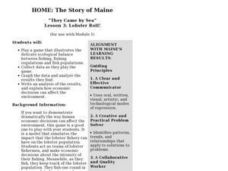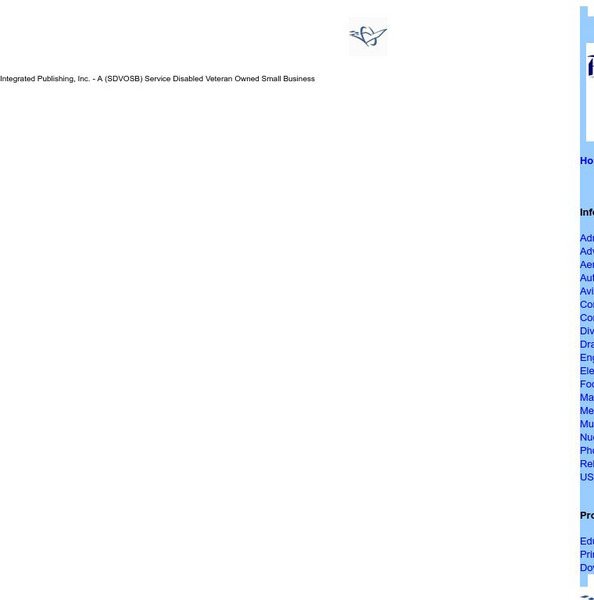Curated OER
Weather Chart
Students select at least 6 cities from around the world to keep track of their high and low temperatures over a period of time.
Curated OER
Lesson 5: Publication After the Interview
Students lear about the publishing/writing process such as the outline, rough draft, MLA Guide for listing sources, and evaluating, revising, and proofreading.
Curated OER
Imaginative Picture Writing
Students create a book about clouds after the teacher reads the book, "It Looked Like Split Milk".
Curated OER
Wacky Weather Stories
Learners observe, identify and creatively express their ideas through literature and dramatize an original story that features a type of weather in the plot.
Curated OER
Archeological Pow-Wow
Students, in groups, examine the use of artifacts and fossils to study people, plants and animals from the past.
Curated OER
Lesson 3: Lobster Roll!
Students play a game that illustrates the delicate ecological balance between fishing, fishing regulations and fish populations. They collect data and analyze the results.
Curated OER
Lesson 1: Design a Transportation Stamp
Students, in groups, research a certain form of transportation that has affected Maine's economic and cultural development. They write a persuasive letter that uses the research to support an argument.
Curated OER
My Spacecraft Model
Young scholars work together to develop their own model of a spacecraft. They complete illustrations and writings to document their work. They present their information to the class.
Curated OER
PowerPoint Postcards
Third graders use the internet to research three facts about a country, state or habitat of their choice. Using this information, they create slides in PowerPoint to connect the information. They share their slides with the class and...
Curated OER
Interpreting a Story from a News Article
Students read and retell a story form out of the newspaper. They write to communicate ideas, stories, letters, simple explanations, and short reports. They edit and perfect their projects for homework, and they share their work with the...
Curated OER
"First Day of School - Make a Puzzle"
Third graders create a puzzle piece to be included in a class puzzle. They are given one puzzle piece, and they decorate it using symbols/drawings which are personal to them such as hobbies, interests, or self-portrait. The pieces are...
Curated OER
Watershed Analysis
Students conduct a regional watershed analysis of an area of their choosing. Using on-line data and their personal knowledge of the area, they determine the annual hydrologic budget and teach the class about "their" watershed.
Curated OER
Round to the Nearest Whole $
In this rounding money worksheet, learners identify the money amounts in each examples and round to the nearest dollar for the 10 examples.
Other
Life Long Earning: Communication Skills
Brief definitions of communication skills terms along with examples of how a student might combine these skills into projects and real-world applications.
Mind Tools
Introducation to Communication Skills
This article reveals the purpose of communication: to get your message across to others. This may seem elementary, but the process that involves both the sender of the message and the receiver is complex and can lead to confusion and...
Integrated Publishing
Integrated Publishing: The Communication Process
With text and diagrams, this article surveys the communication process, which consists of a message being sent and received, either verbally or nonverbally.
Utah Education Network
Uen: Seed House
Students will communicate in oral, artistic, written and nonverbal form as they study seeds and their growth. Students will plant seeds, make observations about the seeds' growth, and report their observations to peers .
Utah Education Network
Uen: Food Pyramid
This four-part lesson plan engages students in oral, written, and artistic tasks as they learn about the Food Pyramid. Students will learn the importance of eating a healthy diet.
AdLit
Ad lit.org: Key Literacy Component: Vocabulary
What's in a word? Mastery of oral and written vocabulary promotes comprehension and communication. Find out how proper instruction can help students who struggle with vocabulary.
Scholastic
Scholastic: Eric Carle Biography
Discover more about your favorite children's author, Eric Carle, when you visit this biography. Students and teachers will gain a new perspective of this author's life and work.
Books in the Classroom
Carol Hurst's Children's Literature Site: Eric Carle
What do you know about Eric Carle, the author? This Carol Hurst site highlights some interesting facts about this author's life and refers to some of his books.
Scholastic
Scholastic: Tomie De Paola's Biography
This resource features a booklist for Tomie dePaola. There is a summary and a picture of each book.
Alabama Learning Exchange
Alex: Those Cells Look Good Enough to Eat.
This is a student led activity utilizing visualization and association to memorize the parts of animal and plant cells. Students will work cooperatively to develop drawings to connect the parts of cells to one of their favorite things:...
Other
Engineering Your Future Ohio: Push 'N Go Product Dissection
Students work in teams to take apart a toy, and, after the product dissection, write directions for reassembling the toy.

























